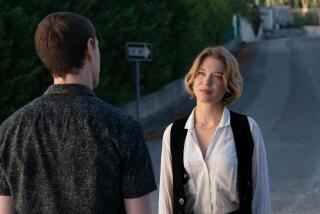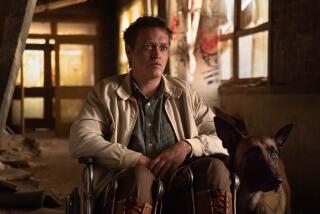TIFF: In ‘Heart of a Dog,’ Laurie Anderson goes from the canine to the spiritual

“Heart of a Dog” filmmaker Laurie Anderson at the Venice Film Festival on Sept. 9.
You can tell a lot about a movie by how it begins. So what to divine from a start that has a narrator describing her desire to sew her dog into her stomach so she can give birth to it?
A lot, apparently, if it and the rest of “Heart of a Dog” are any indication. The new documentary/video diary from the downtown figure Laurie Anderson is a deep dive into existential, Eastern and other forms of meditative thinking, accompanied by a bevy of compelling images and musical passages. Though just 75 minutes, it’s the kind of film you want to fall into and get lost in.
“Heart of a Dog” is the highest-profile movie for the musician, performance artist and filmmaker since “Home of the Brave” 29 years ago, and she carries it off with a mix of footage both ordinary and experimental. There is a sprinkling of re-enactments and a score befitting Anderson, who also narrates it.
FULL COVERAGE: Toronto and other film festivals
Making a key stop at the Toronto International Film Festival ahead of a release in the U.S. later this fall -- it opens in Los Angeles Nov. 6 -- “Heart of a Dog” asks viewers to hit pause (paws?) on conventional filmgoing expectations and instead contemplate larger life questions.
The movie is about the loss of Anderson’s dog, though also implicitly about deaths much greater — that of late husband Lou Reed and the idea of death generally. Though its premise appears almost comic, “Heart of a Dog” in the end land as a kind of cinematic equivalent of Joan Didion’s “The Year of Magical Thinking,” using the personal to explore the profoundly global.
It also is squarely set in a post-9/11 world, interested in the fragility of life and the paranoid obsessions that followed it.
In a soothing, singsong voice that will mostly lull you in (there may occasionally be moments when you want to clench your fists), Anderson describes her thought process during various life moments of the last 15 years, beginning with the aftermath of Sept 11, when she took her rat terrier, Lola, on a trip to Northern California. It was there that she began getting into said canine’s thought process. (Upon seeing a hawk contemplate attacking Lola, Anderson watches as the dog comes to a new realization, after witnessing the skybound predator, that “there is a whole new 180 degrees i am responsible for.”)
There is a general ethereal quality to the film. On a childhood memory (shown via re-enactments) of a technical worker she’d pass on the way to school, she ponders, “He did not work for the phone company — he was in a dream world of trees and circuits.”
Anderson is forever connecting the banal to the profound. The 2000s-era New York City transit warning “If You See Something, Say Something” reminds her of a line Wittgenstein might write.
And Anderson is generally fascinated by the reaction to 9/11, including data collection, wondering about the spiritual implications of reams of bytes being gathered at the NSA’s data center in Utah or the constant video surveillance on daily life. She muses that people in such video can appear to be walking backward, just as Kierkegaard said life is meant to be experienced.
SIGN UP for the free Indie Focus movies newsletter >>
There are questions about further-flung ideas, such as bioethics: putting a dog to sleep, for instance, is something she resists even when its fate is clear. Tibetan monks teach us that humans deal with mortality by approaching death and backing away. Who are we, she asks, to deprive dogs of that same cathartic experience?
She also has more absurd/whimsical experiences involving her pooch. To wit: “When Lolabelle went blind, Elizabeth said she should learn piano.” (Elizabeth is the dog’s trainer, and that decision was carried out.)
There are few comparisons for “Heart of a Dog,” which occupies the space between experimental and conventional documentary filmmaking. It certainly follows no visible structure and does not explore any topical issue though is far more graspable and concrete than any (traditional) experimental film you’ll see.
One comparison that comes to mind is a documentary that played here last year, Ethan Hawke’s “Seymour: An Introduction,” in which the actor-director queried the pianist Seymour Bernstein about the meaning of life and art. Though more conventional in format, that film had a similar ambition, and soul: to ask what it’s all about...and use the medium of film to inch ever closer to an answer.
More to Read
Only good movies
Get the Indie Focus newsletter, Mark Olsen's weekly guide to the world of cinema.
You may occasionally receive promotional content from the Los Angeles Times.







